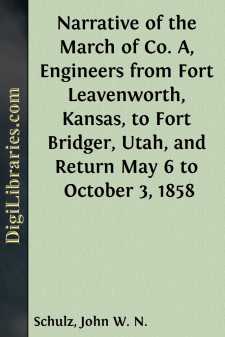Categories
- Antiques & Collectibles 13
- Architecture 36
- Art 48
- Bibles 22
- Biography & Autobiography 813
- Body, Mind & Spirit 142
- Business & Economics 28
- Children's Books 17
- Children's Fiction 14
- Computers 4
- Cooking 94
- Crafts & Hobbies 4
- Drama 346
- Education 46
- Family & Relationships 57
- Fiction 11829
- Games 19
- Gardening 17
- Health & Fitness 34
- History 1377
- House & Home 1
- Humor 147
- Juvenile Fiction 1873
- Juvenile Nonfiction 202
- Language Arts & Disciplines 88
- Law 16
- Literary Collections 686
- Literary Criticism 179
- Mathematics 13
- Medical 41
- Music 40
- Nature 179
- Non-Classifiable 1768
- Performing Arts 7
- Periodicals 1453
- Philosophy 64
- Photography 2
- Poetry 896
- Political Science 203
- Psychology 42
- Reference 154
- Religion 513
- Science 126
- Self-Help 84
- Social Science 81
- Sports & Recreation 34
- Study Aids 3
- Technology & Engineering 59
- Transportation 23
- Travel 463
- True Crime 29
Narrative of the March of Co. A, Engineers from Fort Leavenworth, Kansas, to Fort Bridger, Utah, and Return May 6 to October 3, 1858
Description:
Excerpt
In the spring of 1858, when the Government met with opposition from the Mormon community, in relation to the appointment of Mr. Cummings as Governor of the Territory, and Brigham Young's corps of Danites was being recruited and drilled for active service, it was decided that a military force should be sent to the seat of the trouble to maintain the National authority. The expedition numbered several thousand men—cavalry, artillery, and infantry.
As the grass along what was known as the "Emigrant Route" had been almost entirely consumed by the numerous mule and ox-trains which had passed over the Plains during the preceding year, it was found necessary to make a new road, from the Platte River to the Green, over which the Army could march.
To perform this duty with sufficient speed to avoid delaying the advancing columns, sixty-four selected men, under First Lieut. James C. Duane and Second Lieut. Edward P. Alexander, were taken from Company A, United States Engineers, then stationed at the Military Academy at West Point, N.Y. Leaving a detachment at West Point, the Company started on this service March 31st, 1858, going by rail and steamboat as far as Fort Leavenworth, Kans. Here it remained in barracks until fully equipped to encounter the vicissitudes of the Western Plains. The march to Utah, proper, was begun the 6th of May, 1858.
Narrative of the March
May 6 (Thursday). With bright anticipations of beholding many a novel and interesting scene, and with high expectations of enjoying the new and eventful life which was about to open before us, we left Fort Leavenworth behind on the 6th day of May, 1858. Before us lay a long march—twelve hundred miles, we were told—across a wild, and, except for the first two hundred miles, a desert and uninhabited country.
Eight wagons, each drawn by six sturdy mules, drove up in front of our quarters, and, after receiving their baggage, started for the first camping ground at Salt Creek, a distance of about four miles. The wagons were accompanied by a detachment to serve as escort and to pitch the tents.
The remainder of the Company followed an hour or two later, in heavy marching order. Except for the observance of discipline, and the order of our marching, no one would have supposed us to be an organized portion of the United States Army. We each wore a white felt hat and a gray or blue woolen blouse, or hunting shirt. There were belt, bayonet, haversack, canteen, pistol, a large clasp knife—all surmounted by knapsack and rifle. To we Eastern soldiers this tout ensemble seemed ludicrous enough.
We pitched our first camp, manifesting considerable delicacy about taking our meals al fresco, and being very particular to select the driest and softest spots on which to make our beds.
May 7 (Friday). Reveille was at an early hour. We stowed our cumbrous knapsacks with the rest of the baggage in the wagons, and then set out on our march with lighter bodies and gayer hearts. The day's journey was only sixteen miles, but the roads were in poor condition from the breaking up of winter, and to us, unaccustomed to continuous marching, it seemed an endless distance. Several times during the day we were obliged to turn ourselves into mules, and assist in pulling the wagons out of mud holes. The night's camp was at Oak Grove.
May 8 (Saturday). The next day we went as far as Ravine Spring, six miles. We made but a short march, owing to the miserable condition of the roads....


